Ecosystem Partners
Circuit Design Support
We have registered schematic data for power supply integrated circuits to support your design and development. We will continue to add products as needed, please kindly use them together.-
Lightricity manufactures and sells the world’s most efficient indoor PV technology (though it works excellently outdoors, too). It converts indoor light to energy with up to 35% efficiency – a more than six-fold improvement on conventional PV. A panel the size of a fingertip will power an IoT device forever. Even in extremely low indoor light, opening possibilities to power IoT devices not previously thought possible with indoor light. We offer two solutions. For those designing new connected devices, our customisable PV panels can be integrated into any low-power IoT device as an alternative to primary batteries. For IoT systems integrators, we offer off-the-shelf, easy-to-integrate, completely maintenance-free PV-powered sensors for many common measurement and tracking applications.
Lightricity EXL1-1V20 indoor solar cell Performance (200 lux white LED spectrum) Size 11.65 x 8.85 x 0.65 mm3 Active area 98 mm2 Number of cells 1 Open circuit voltage 1.15 V Short circuit current 22.7 µA Operating voltage 1.0 V Operating current 21.7 µA Operating power 21.7 µW Power density (active area) 22.1 µW/cm2 -
XC6240
Feature LDO for chatge Input Voltage 1.5-6.0V Output voltage 2.63V (typ.) Output Current 150mA Current Consumption 0.8μA VOUT sink current 0.24μACircuit Diagram
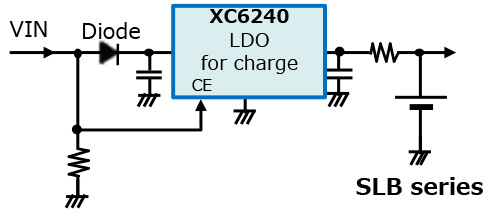
XC6215
Feature LDO for current limit Input voltage 1.5-6.0V Output voltage 0.9-5.0V Output current 200mA Current consumption 0.8μACircuit Diagram

XC8109
Feature Load SW with Current Limit IC Input Voltage 2.5-5.5V Current limit 75mA~ Current consumption 40µACircuit Diagram

XC6140
Feature RESET to detect voltage drop Input Voltage 1.1-6.0V Detection voltage 1.6-2.2V Release voltage 2.475V Current consumption 104nA (detection)Circuit Diagram

-
BD71631QWZ
Function Linear Charger Input voltage 2.9~5.5V Charge current 1~300mA Charger voltage 2.0~4.7V Re charge voltage 1.8~4.7V termination current 50μA~10mA VOUT sink current during standby 0μA(typ) Operating Temperature -30~105℃ LDO for current limiting No need Load switch for current limiting No need Input diode for backflow countermeasures No need 10 hour safety timer Built-in Battery temperature protection (Additional thermistor) Built-in Battery overvoltage protection Built-inApplication circuit diagram
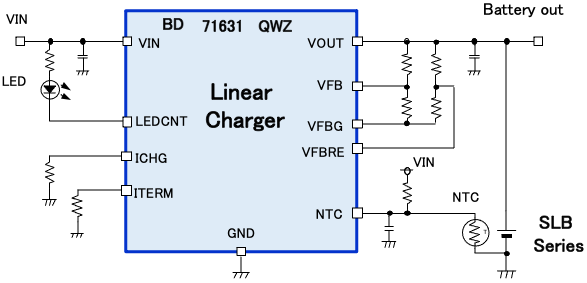
BU42xx series and BU43xx series
Function Voltage detector for detecting battery voltage drop Reset Active Voltage Range 0.7V to7V Detection voltage 0.9V to 4.8V Hysteresis Voltage Detection votaltage x 0.05 Circuit Current (ON) [µA] 400nA Circuit Current (OFF) [µA] 550nA Operating temperature -40~125℃Application circuit diagram
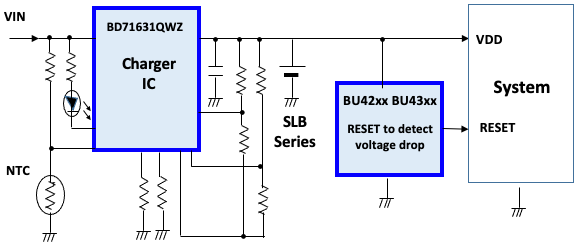
-
MAX1722x
Function Boost Converters Input voltage range 0.88V~5.5V Minimum input voltage MAX17220 MAX17224 MAX17226 0.4V (ETP: enable transient protection) Output voltage range 1.8V to 5V Operating temperature -40℃ to 125℃Application circuit diagram

MAX77827
Function Buck-Boost Converter Input voltage range 1.8V~5.5V Output voltage range 2.3V~5.3V Operating temperature -40℃~125℃Application circuit diagram
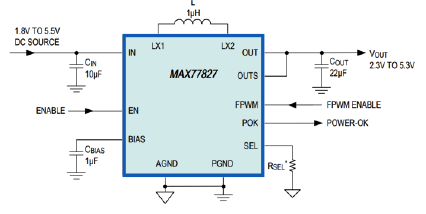
LTC4079
Function Linear Charger Input voltage range 2.7V~60V Output voltage range (Charging voltage) 1.2V~60V Charge current range 10mA~250mA Operating temperature -40℃~125℃ Automatic recharge yes Temperature qualified charging yes Adjustable safety timer yesApplication circuit diagram
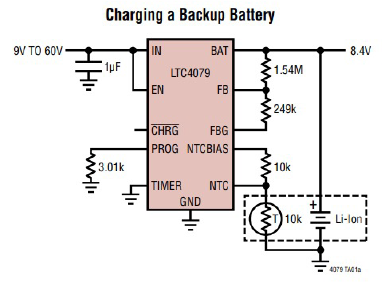
-
S-19192
Function Battery monitoring (3 to 6cells) Overcharge detetion voltage 2.500V to 4.500V Overdischarge detection voltage 1.500V to 3.000V Current consumption 18 uAmax.Schematic (Block Diagram)
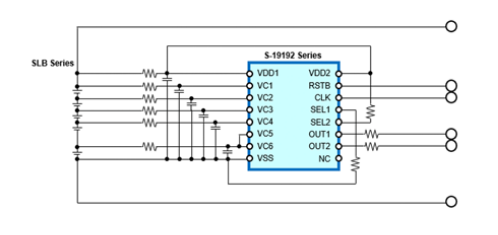
S-8249
Function Battery monitoring and cell balance Overcharge detetion voltage 2.000V to 4.600V Cell balance detection voltage 2.000V to 4.600V Current consumption 2.0 uAmax.Schematic (Block Diagram)
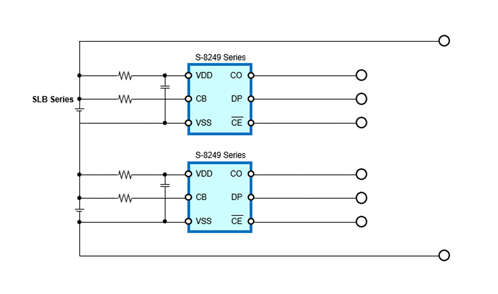
S-8269B
Function Discharge / Charge overcurrent monitoring Discharge overcurrent detection voltage 1 0.0030 V to 0.1000 V Discharge overcurrent detection voltage 2 0.010 V to 0.100 V Charge overcurrent detection voltage −0.1000 V to −0.0030 V Load short-circuiting detection voltage 0.020 V to 0.100 V Current consumption 4.0 uAmax.Schematic (Block Diagram)
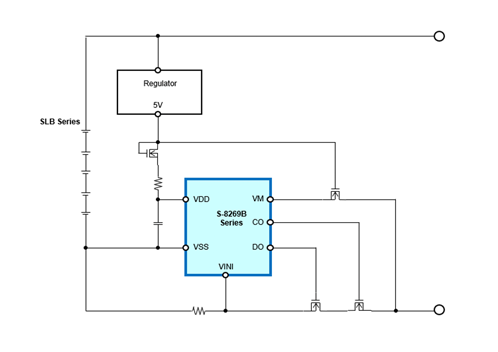
S-8215C
Function Battery protection (3 to 5cells) Overcharge detetion voltage 2.700 V to 4.700 V Current consumption 0.7 uAmax.Schematic (Block Diagram)
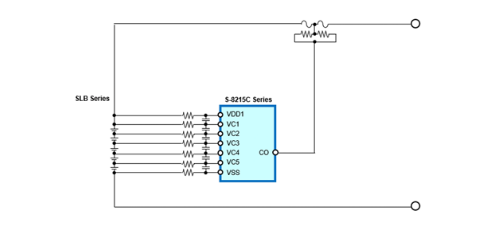
S-8265C
Function Battery protection and cell balance(3 to 5cells) Overcharge detetion voltage 2.700 V to 4.700 V Cell balance detection voltage 2.700V to 4.650V Current consumption 0.7 uAmax.Schematic (Block Diagram)
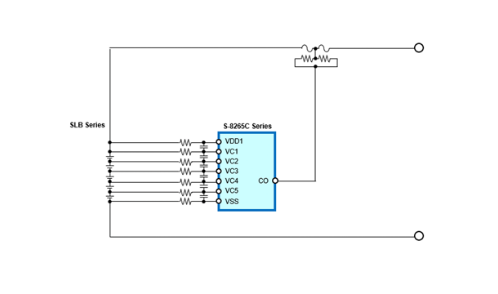
S-1740/41 Series
Function LDO with supply voltage divided output for IoT Operating voltage range 1.5V to 5.5V Output voltage range 1.0V to 3.5V (selectable in 0.05V steps) Current consumption 0.35 μA typ. (Ta=+25°C) Output voltage accuracy ±1.0% (±15mV at 1.0V~1.45V) Output current 100 mA voltage divider output(PMOUT) VIN/2 (S-1740 series) VIN/3 (S-1741 series)Schematic (Block Diagram)
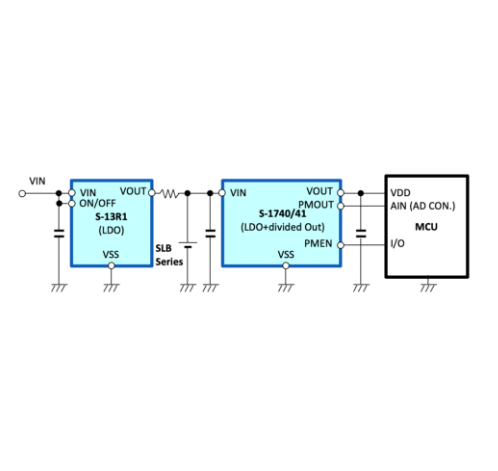
S-8354 Series
Function High efficiency at small load step up swiching regurator Operating voltage range 0.9 V(Iout=1 mA) to 10V Current consumption 18.7µA typ. (at 3.3 V, 50 kHz) Output voltage 1.5 V to 6.5 V (VDD / VOUT separate type) Switching current 231mA (at S-8354D30) Soft start function 6ms typ. (at 50kHz) Control type PWM/PFM automatic switchingSchematic (Block Diagram)
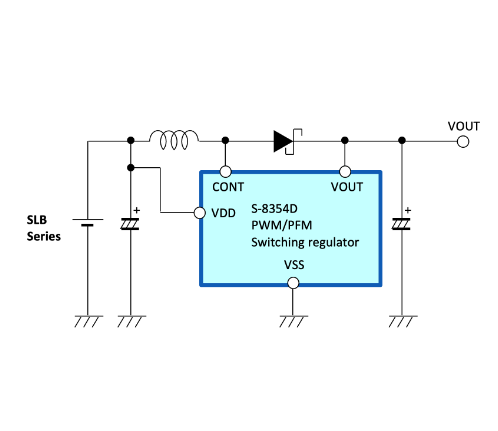
S-8474/S-8471/S-85S1A Series
Function Wireless power supply+Step down constant voltage charging and output. Operating voltage range 4.5 to 6.5V (Wireless power supply) Current consumption (S-85S1A) 260nA (quiescent current) Output voltage (S-85S1A) 0.7Vto2.5V,in0.05Vstep 2.6Vto3.9V,in0.1Vstep Output current 100 mA Control type (S-85S1A) COT controlSchematic (Block Diagram)
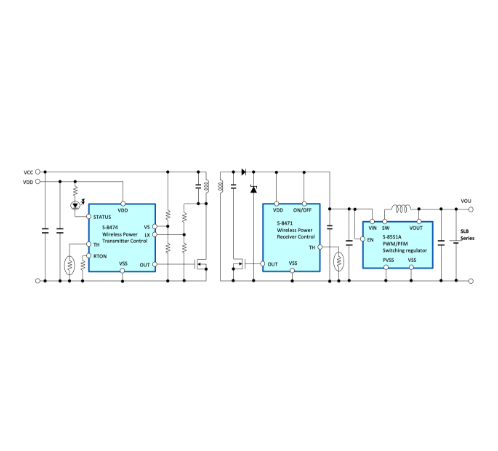
-
AEM10330
Function PMIC for photovoltalic energy harvesting Input voltage range 100mV to 4.5V Cold start 3μW @ 275mV Input power range 3μW to 570mW Output current 30mA (Low power mode) 60mA (High power mode) Selectable load voltage from 1.2V to 3.3V MPPT Yes Package QFN40 5 x 5 mmApplication circuit diagram
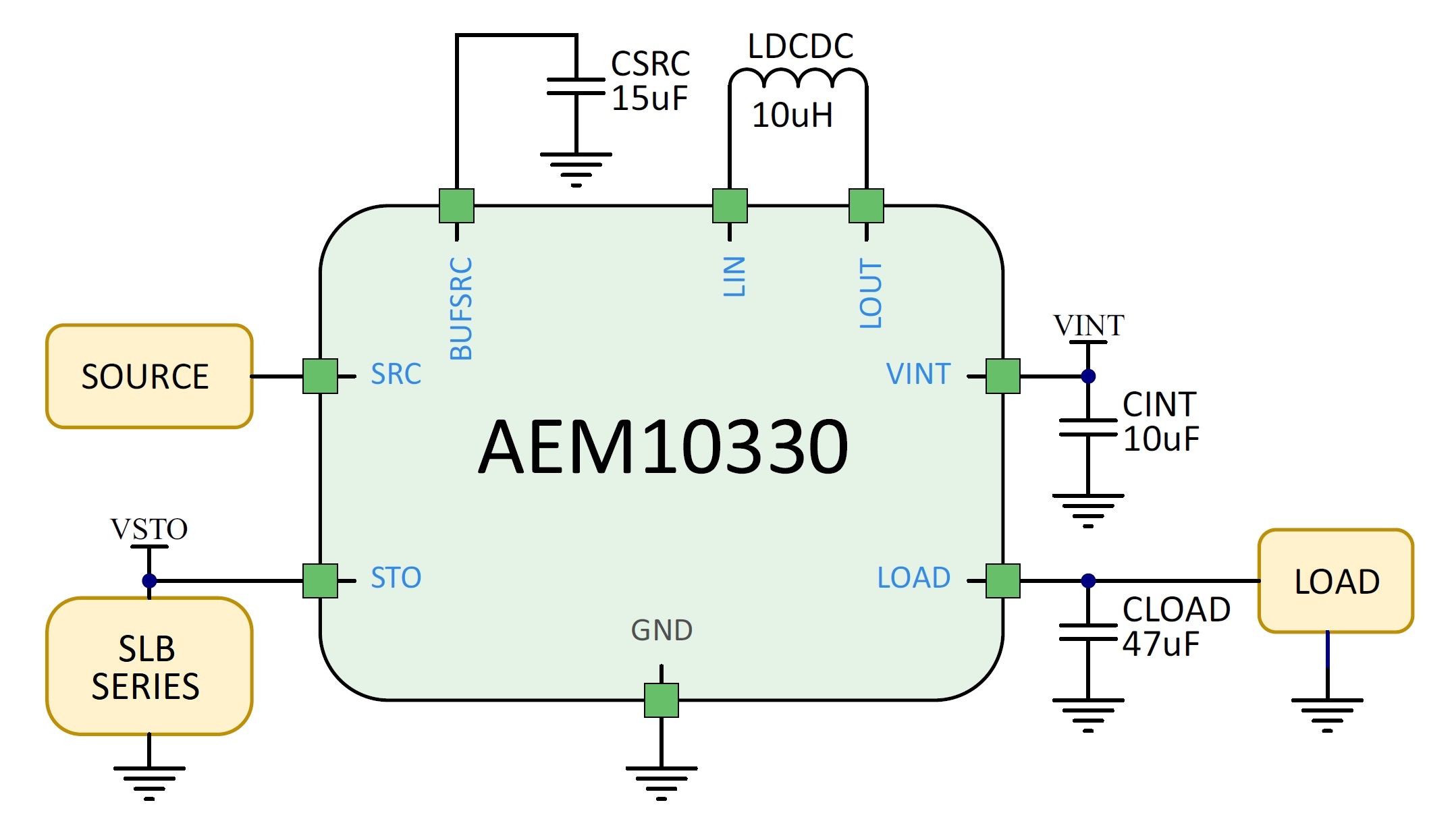
AEM30330
Function PMIC for vibration energy harvesting Input voltage range 100mV to 4.5V Cold start 3μW @ 275mV Input power range 3μW to 570mW Output current 30mA (Low power mode) 60mA (High power mode) Selectable load voltage from 1.2V to 3.3V MPPT Yes Package QFN40 5 x 5 mmApplication circuit diagram
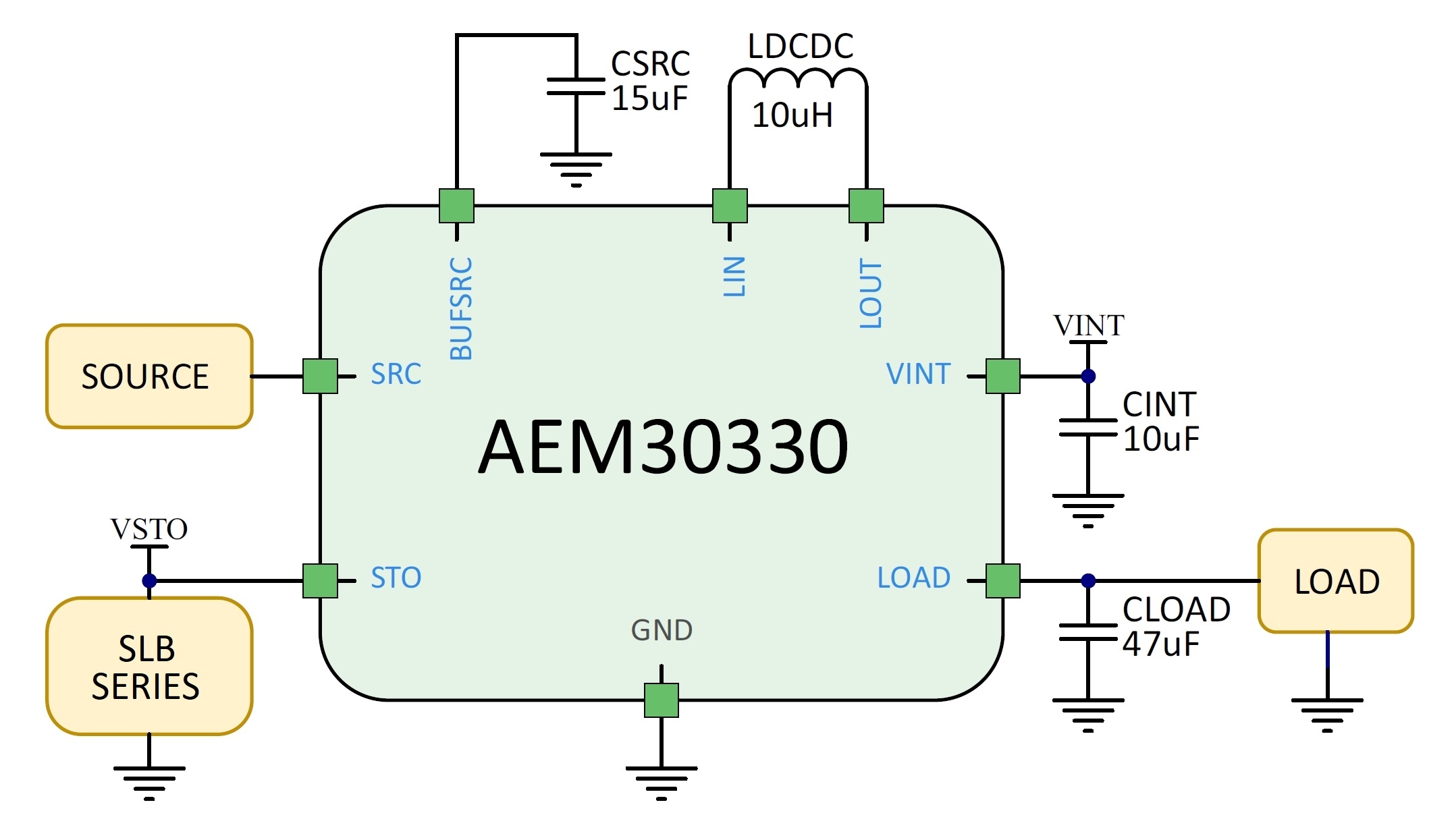
AEM10300
Function Photovoltalic energy harvesting battery charger Input voltage range 100mV to 4.5V Cold start 3μW @ 275mV Input power range 3μW to 570mW Pout N/A MPPT Yes Package QFN28 4 x 4 mmApplication circuit diagram
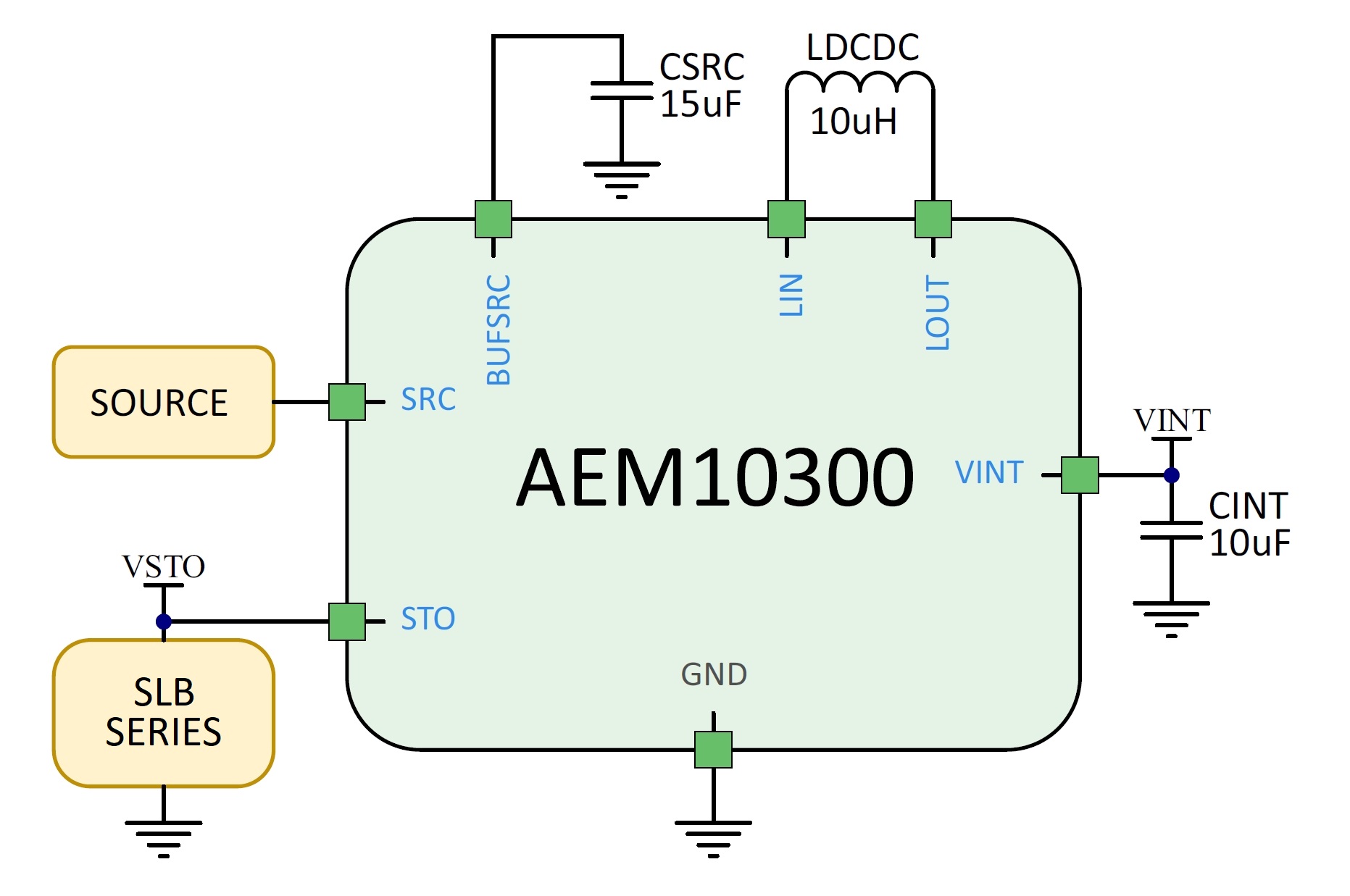
AEM30300
Function Vibration energy harvesting battery charger Input voltage range 100mV to 4.5V Cold start 3μW @ 275mV Input power range 3μW to 570mW Pout N/A MPPT Yes Package QFN28 4 x 4 mmApplication circuit diagram
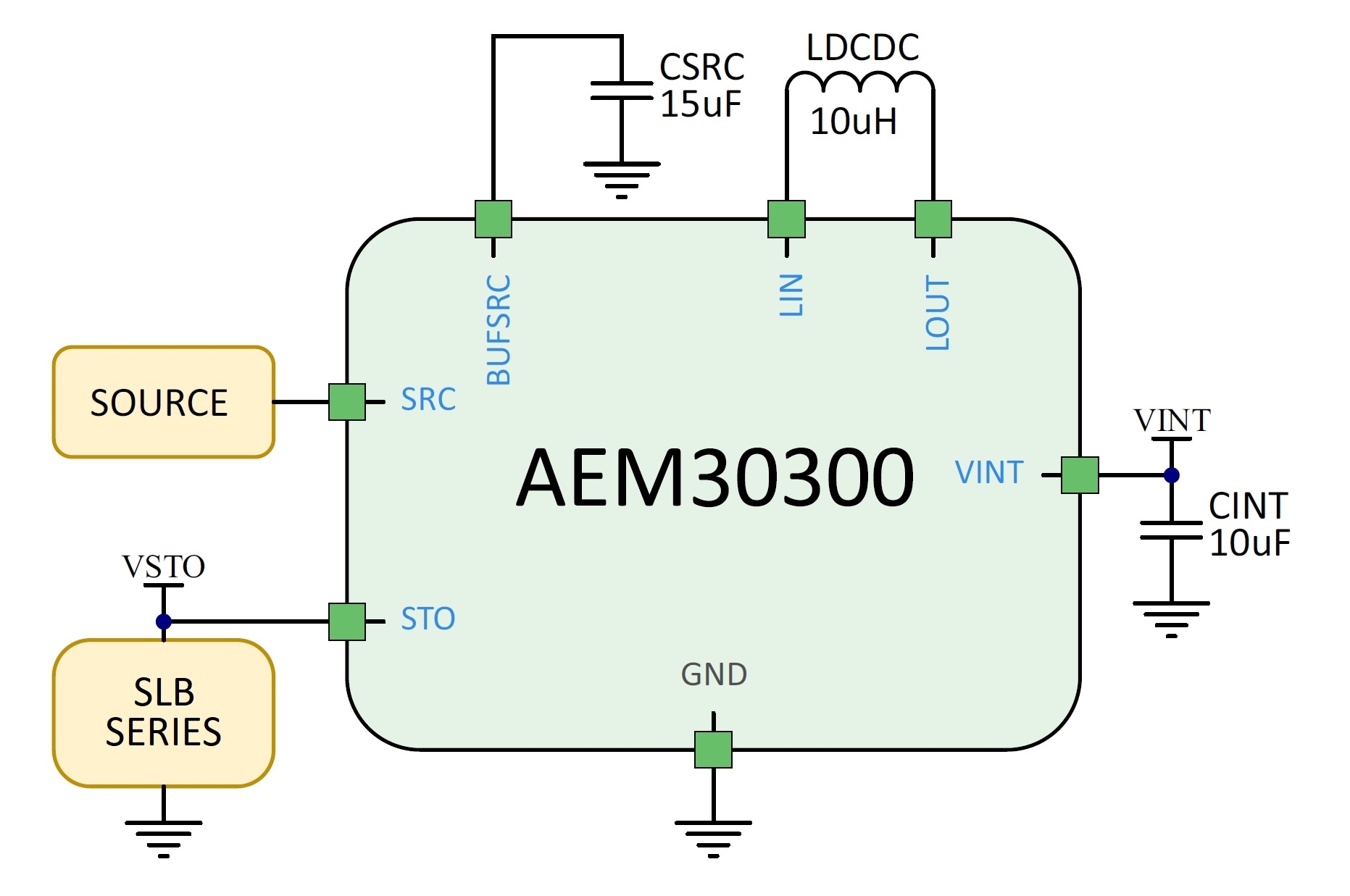
-
Otii Ace Pro
Function The instrument that can precisely source and simultaneously measure voltage and current. It computes power and energy, and syncs with software output, enabling engineers and developers to easily see what drains the energy and optimize the battery life of their devices under test. Source (Voltage) 0V to 25V Source (Power) up to 30W, 50W peak Sink (Power) – requires Battery Toolbox license up to 15W, 125W peak Current measurementResolution 0.4nA Accuracy ±(0.05% + 25 nA) Sample Rate up to 50ksps Voltage measurementAccuracy ±(0.01% + 1 mV) Sample rate up to 50kspsApplication circuit diagram
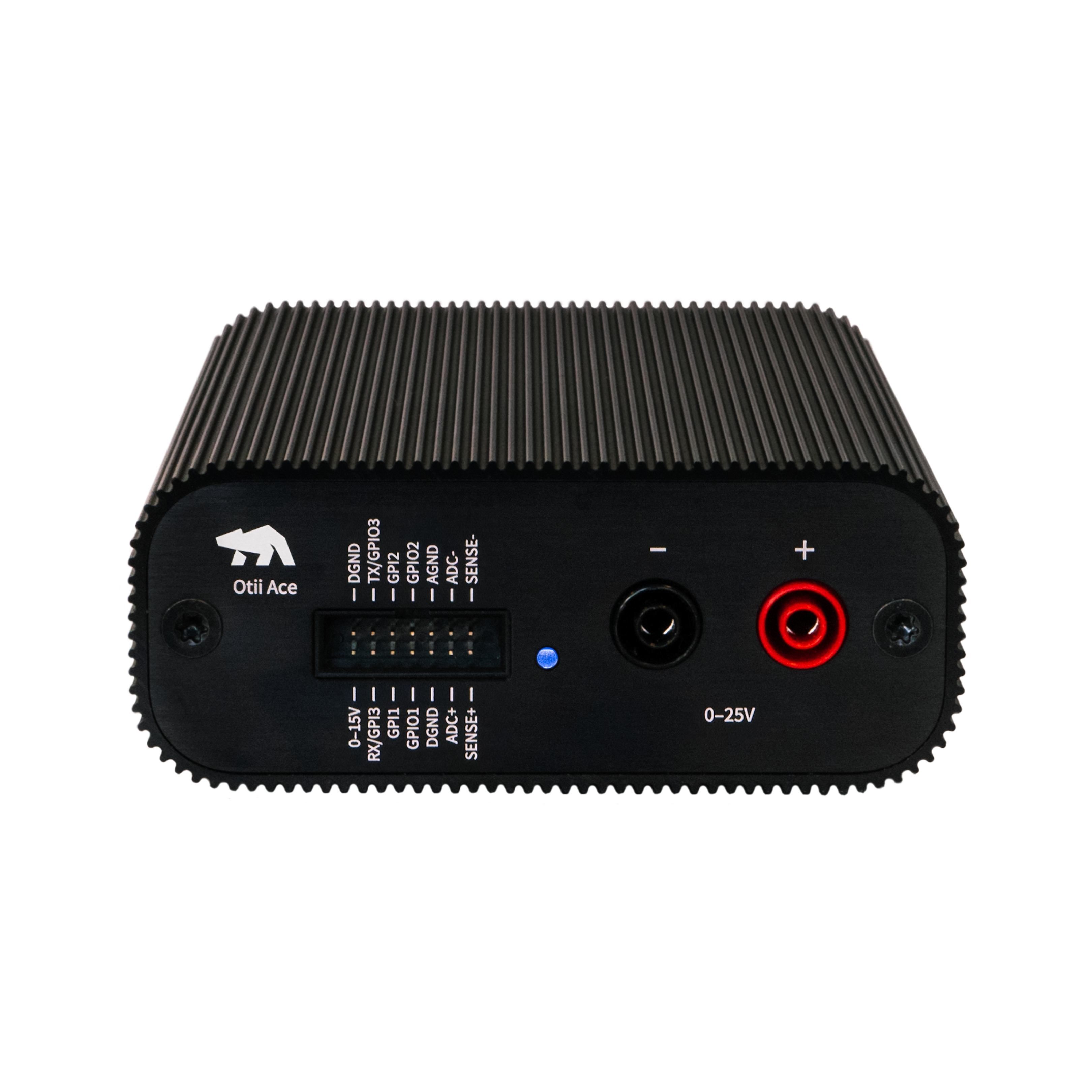
Otii Battery Toolbox
Function Otii Battery Toolbox (BT) is a software add-on that upgrades Otii Ace Pro to a powerful battery profiler and emulator. Points in Emulation as many as no of iterations ESR Range (1) up to 5 kohm ESR Resolution down to 1 mohm Voc Range 0V to 25V Voc Resolution 1 mV Capacity Range no limit Capacity Resolution 1 µAhApplication circuit diagram

Otii Battery Toolbox emulates the total ESR -
Founded in 2013, Ossia is redefining how electronics receive power. Ossia’s patented Cota® technology safely delivers targeted energy to devices at a distance – without pads, cords or even line-of-sight. A single Cota RF smart antenna automatically keeps multiple devices charged without any user intervention, enabling an efficient and truly wire-free, powered-up world, that is always on and always connected.
-
Exeger is a Swedish company that invented and manufactures solar cells that drive new possibilities for light-powered products. The solar cells, called Powerfoyle, transform any kind of light – indoor or outdoor – into electrical power. Powerfoyle has a uniquely flexible and customizable design to integrate seamlessly for sustainable and attractive products.

-
Matrix Industries is a pioneer of self-powered machine-learning solutions for connected devices. We deploy and collect actionable sensor data at the edge with our Perceptive and Proximity product lines. Each product includes our advanced low-power machine learning algorithms and unique energy harvesting technology that eliminates the need to recharge or replace batteries. With Perceptive and Proximity, you can monitor your connected devices from the cloud using our APIs and take meaningful action with that data.
-
Powercast is the pioneer and leader of long-range, power-over-distance wireless charging technology using broadcasted RF energy (radio waves) converted into DC power. Since 2003, the company has provided solutions combining its FCC-approved transmitters and receiver chips to enable automatic, over-the-air charging of multiple devices – no charging mats or direct line of sight needed.
-
PowerFilm specializes in custom solar solutions meeting design, power-output, and timeline needs of customers. Controlling each step in engineering, design, and production, PowerFilm delivers the highest quality and performing systems. Our amorphous silicon functions at incredibly low light levels making it perfect for IoT, indoor, and many outdoor applications. Modules have been used for a wide range of applications including solar tents for the Army, powering electronics on a space exploration vehicle and custom asset tracking solutions. PowerFilm has been developing and manufacturing its unique flexible solar technology for nearly three decades, making it one of the few, and maybe the oldest, surviving solar manufacturers in the United States.
ONP2.4-15x94 Classic Application Series Solar Panel
 Classic Application panels are lightweight, paper-thin, and durable.
Their ultra-thin, flexible profile enables easy integration into devices for solar recharging or direct power. These panels do not have a UV-stabilized surface but are suitable for intermittent outdoor use.
Classic Application Series panels are optimized to collect sunlight outdoors and are a small representation of PowerFilm’s wide range of custom options, including size, voltage, and more.
These panels are well suited to power the wireless devices and sensors of the emerging IoT industry and many other electronics. Sizes range from inches to feet squared with a standard thickness of 0.22mm.
This thin-film amorphous silicon flexible solar module is laminated with standard duty PET and foil tape contact terminals. It’s well suited to collect direct sunlight and indirect light in shady areas. A long product lifetime can be achieved when the module is assembled with adequate moisture and UV mitigation.
Custom panel options are available.
Electrical Specifications
100% Sun: 18.6mA at 2.4V (44.7mW)1
25% Sun: 4.19mA at 2.4V (10.1 mW)
Max Voc: 3. 7V
Average lsc: 24.2mA
Mechanical Specifications
f/b Laminate: 3 mil PET / 3 mil PET
3/16 in Copper Foil Busbar
2 x 2 mm Exposed Backside Contacts
Thickness: 0.2-0.3mm
Appr. Weight: 0.40 grams
Operating Temperature: -25C to 65C
Bend Radius: 1 inch fixed, 3 inch repetitive
UV and Moisture Protection: Limited
Classic Application panels are lightweight, paper-thin, and durable.
Their ultra-thin, flexible profile enables easy integration into devices for solar recharging or direct power. These panels do not have a UV-stabilized surface but are suitable for intermittent outdoor use.
Classic Application Series panels are optimized to collect sunlight outdoors and are a small representation of PowerFilm’s wide range of custom options, including size, voltage, and more.
These panels are well suited to power the wireless devices and sensors of the emerging IoT industry and many other electronics. Sizes range from inches to feet squared with a standard thickness of 0.22mm.
This thin-film amorphous silicon flexible solar module is laminated with standard duty PET and foil tape contact terminals. It’s well suited to collect direct sunlight and indirect light in shady areas. A long product lifetime can be achieved when the module is assembled with adequate moisture and UV mitigation.
Custom panel options are available.
Electrical Specifications
100% Sun: 18.6mA at 2.4V (44.7mW)1
25% Sun: 4.19mA at 2.4V (10.1 mW)
Max Voc: 3. 7V
Average lsc: 24.2mA
Mechanical Specifications
f/b Laminate: 3 mil PET / 3 mil PET
3/16 in Copper Foil Busbar
2 x 2 mm Exposed Backside Contacts
Thickness: 0.2-0.3mm
Appr. Weight: 0.40 grams
Operating Temperature: -25C to 65C
Bend Radius: 1 inch fixed, 3 inch repetitive
UV and Moisture Protection: Limited
INP3.6-24x44T Indoor Light Series Solar Panel
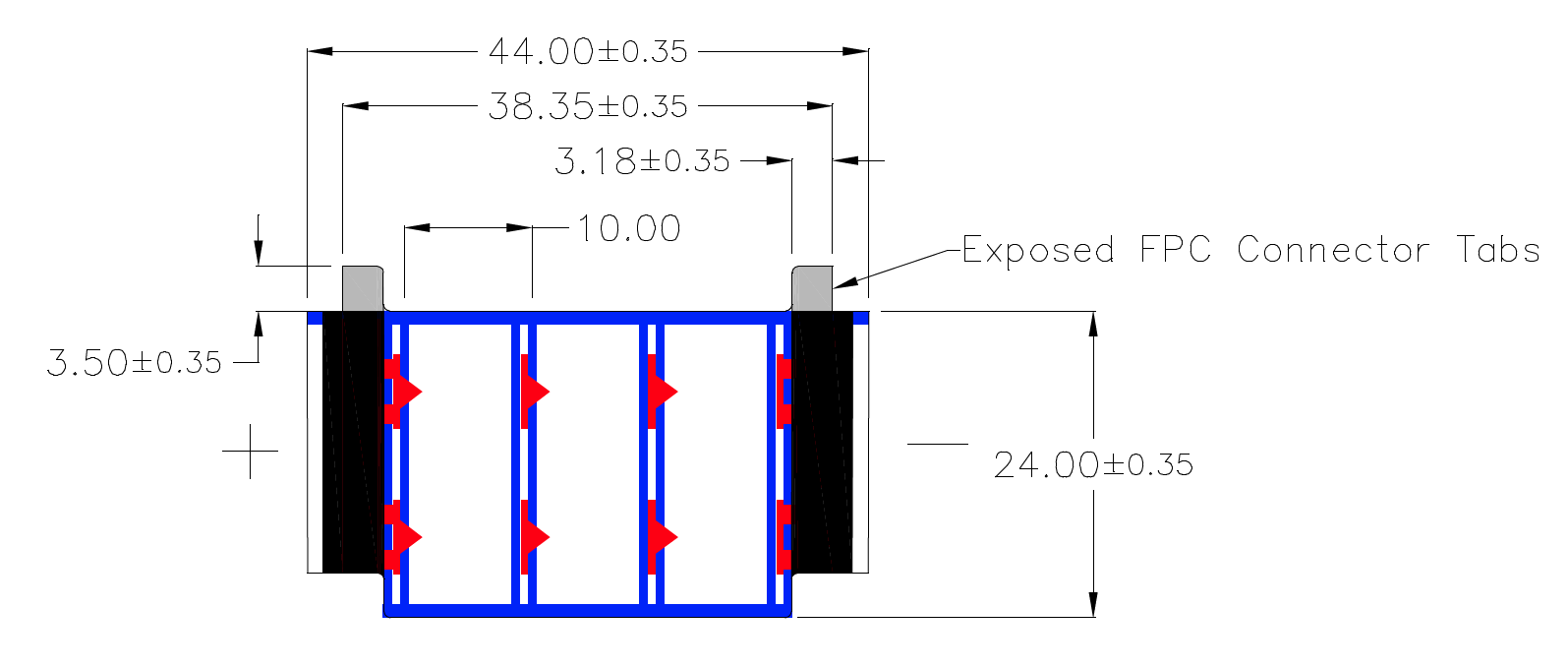 With industry-leading performance, these panels are ideal for integrating with ultra-low power wireless devices, sensors, and electronics. For application notes and examples, check out our Solar Development Kits, which make prototyping and experimenting with these panels simple.
Indoor Light Series panels are compatible with all common indoor light sources, including LED, fluorescent, incandescent, halogen, and indirect sunlight. All panels are tested and are guaranteed to perform in dim 200 lux and brighter 1000 lux environments.
This thin-film amorphous silicon flexible indoor solar module is laminated with standard duty PET and foil tape contact terminals. It’s well suited to collect artificial lighting in indoor settings such as warehouses, offices, and retail spaces.
Custom panel options are available.
With industry-leading performance, these panels are ideal for integrating with ultra-low power wireless devices, sensors, and electronics. For application notes and examples, check out our Solar Development Kits, which make prototyping and experimenting with these panels simple.
Indoor Light Series panels are compatible with all common indoor light sources, including LED, fluorescent, incandescent, halogen, and indirect sunlight. All panels are tested and are guaranteed to perform in dim 200 lux and brighter 1000 lux environments.
This thin-film amorphous silicon flexible indoor solar module is laminated with standard duty PET and foil tape contact terminals. It’s well suited to collect artificial lighting in indoor settings such as warehouses, offices, and retail spaces.
Custom panel options are available.
Electrical Specifications:
1000 Lux: 63.4uA. at 3.2V (l 71uW) 200 Lux 13uA. at 2.4-V (31.luW) Max Voc: 5.55V (Direct Sunlight) Average Isc: 9.8mA. (Direct Sunlight)Mechanical Specifications
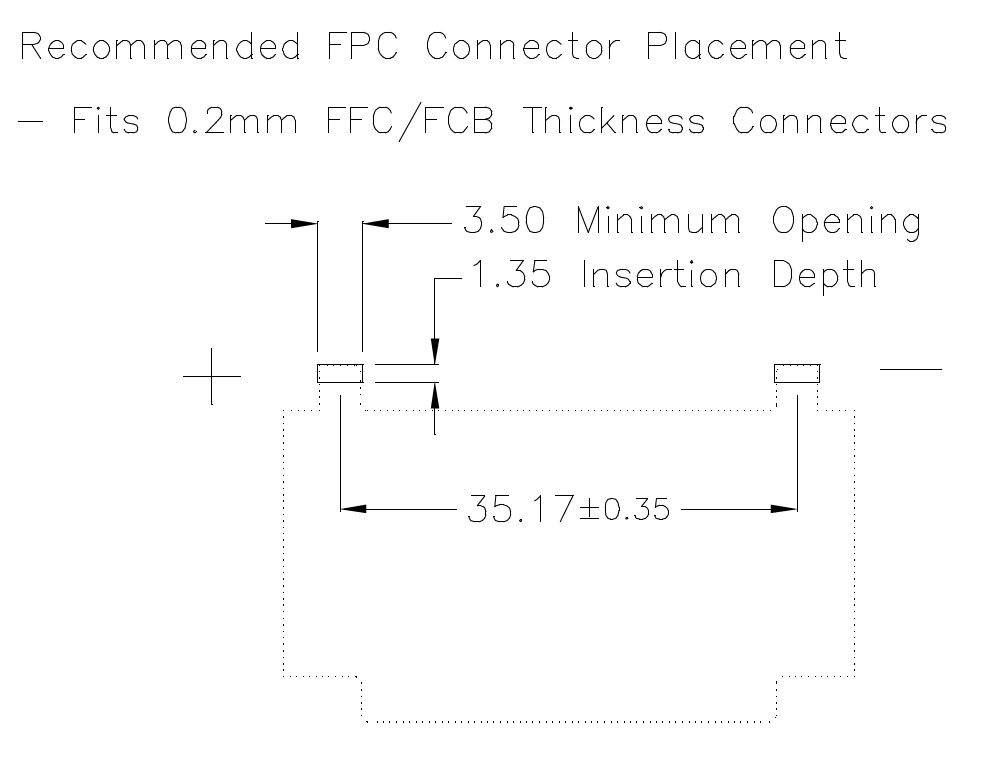 f/b Laminate: 3 mil / 3mil PET
3/16 in Copper Foil Busbar with Black
Thickness 0.22mm
Appr. Weight: 0.26 grams
Operating Temperature: -25C to 65C
Bend Radius: 1 inch static, 3 inch repetitive
UV and Moisture Protection: Limited
Exposed 0.2mm FPC Connector Tabs
f/b Laminate: 3 mil / 3mil PET
3/16 in Copper Foil Busbar with Black
Thickness 0.22mm
Appr. Weight: 0.26 grams
Operating Temperature: -25C to 65C
Bend Radius: 1 inch static, 3 inch repetitive
UV and Moisture Protection: Limited
Exposed 0.2mm FPC Connector Tabs
-
Atmosic™ Technologies is an innovative fabless semiconductor company, designing ultra-low power wireless solutions to dramatically reduce and disrupt device dependency on batteries, aiming to deliver forever battery life and the battery free connected Internet of Things. The company’s products enable the IoT device ecosystem—designers and manufacturers, as well as end users and those responsible for deployments—to dramatically lower costs and efforts associated with maintaining the growing Internet of Things in Personal, Home, Auto, Healthcare, Industrial, Enterprise and Smart Cities segments. In addition to these tangible business advantages, Atmosic aims to reduce ecological impacts with its vision of dramatically reduced battery consumption in the Internet of Things.
-
Ambient Photonics was founded in 2019 in California to bring low light energy harvesting technology to mass scale. With a focus on IoT applications, the company aims to inspire a new generation of connected devices with endless power. Inspired by Photosynthesis, Ambient Photonics’ technology is rooted in the simplicity of nature, but it doesn’t rely on the power of the sun. Instead they looked at how photosynthesis works and turned the science behind it into a bright new idea: use the low-level ambient light that surrounds us everywhere to generate power.
-
Epishine is a leading developer and manufacturer of printed organic solar cells, committed to reducing global environmental impact by enabling innovative and smart technologies to meet the demand for sustainable energy solutions. Epishine's business is based on pioneering manufacturing breakthroughs. Their flagship product is a unique indoor solar cell optimized for harvesting indoor light that is easily integrated into small low-power electronics.
-
About Nexperia
Headquartered in the Netherlands, Nexperia is a global semiconductor company with a rich European history and over 14,000 employees across Europe, Asia, and the United States. As a leading expert in the development and production of essential semiconductors, Nexperia’s components enable the basic functionality of virtually every commercial electronic design in the world – from automotive and industrial to mobile and consumer applications.About NEH7100 Energy Harvesting PMIC
NEH7100 is an inductorless Power Management IC which provides extended energy harvesting capabilities and power management features, including battery protection, LDO and USB charging. This device is a complete power management solution for energy harvesting, enabling engineers to optimize and extend the integration of LTO batteries enabling the device to be fully energy autonomous. Its target applications include wearables, remote controls, consumer electronics such as keyboards or smart tags, industrial sensors and asset tracking.Spec NEH7100BU Supported harvesters PV cells, piezo, TEG, antennas Input power range 15 μW to 100 mW Cold start Yes Storage element voltage 0 – 4.5V Boosting factor 2, 4, 8, 16 Maximum Power Point Tracking (MPPT) Adapts within 0.5s, adjustable to 64s Power management features OVP, LVD, OCP, LDO, USB charging Configurable through Hard-coding; I2C -
ONiO creates the world’s most energy-efficient microcontrollers, redefining how electronic devices are powered. ONiO.zero runs entirely on harvested energy or can dramatically extend battery life, enabling sustainable, maintenance-free electronics. With built-in wireless connectivity and intelligent power management (PMIC), ONiO cuts complexity, reduces costs, and removes the need for frequent battery replacements. From smart sensors to consumer devices, industrial automation, and beyond, we’re bringing self-powered, energy-efficient technology to scale.